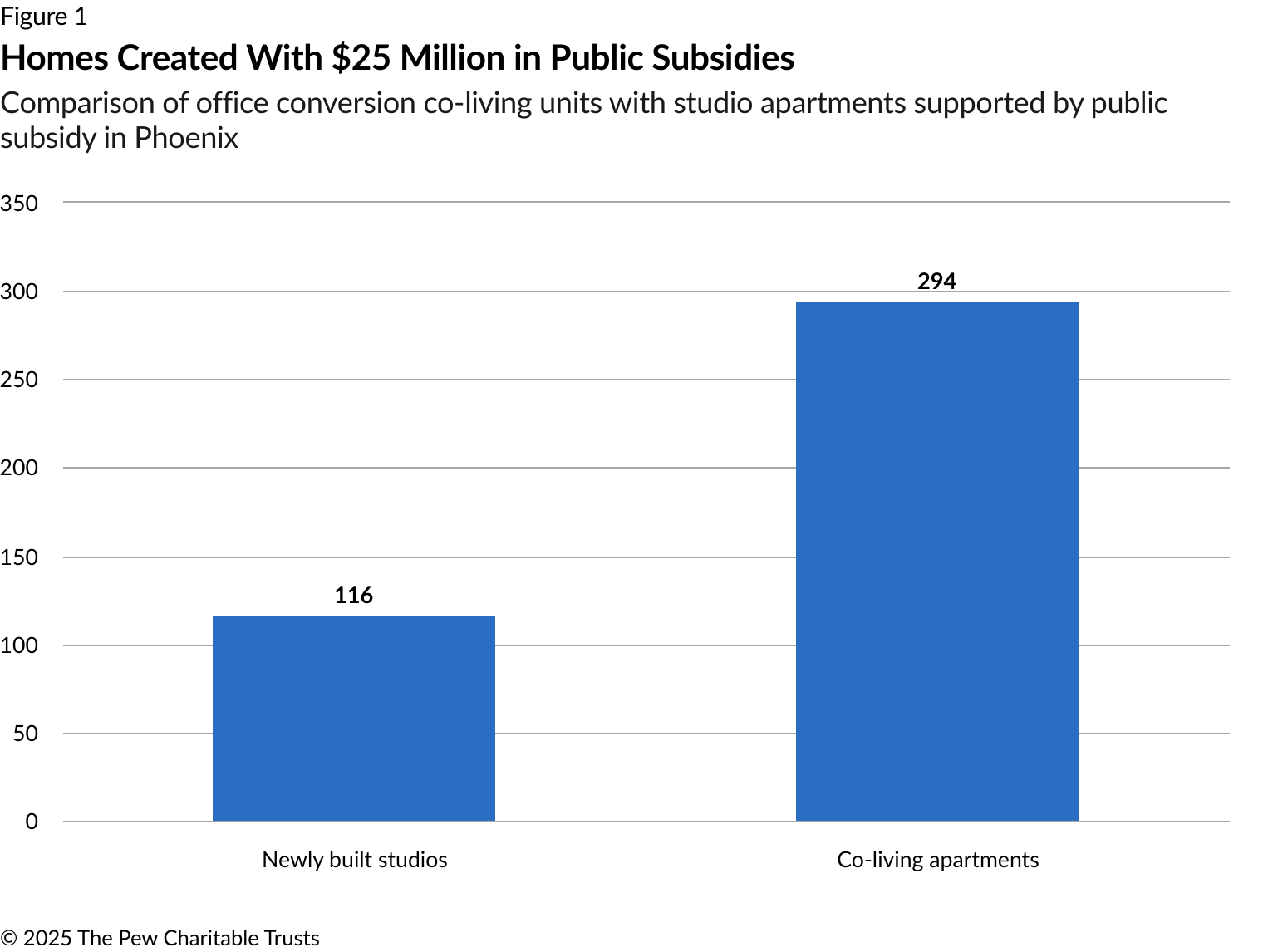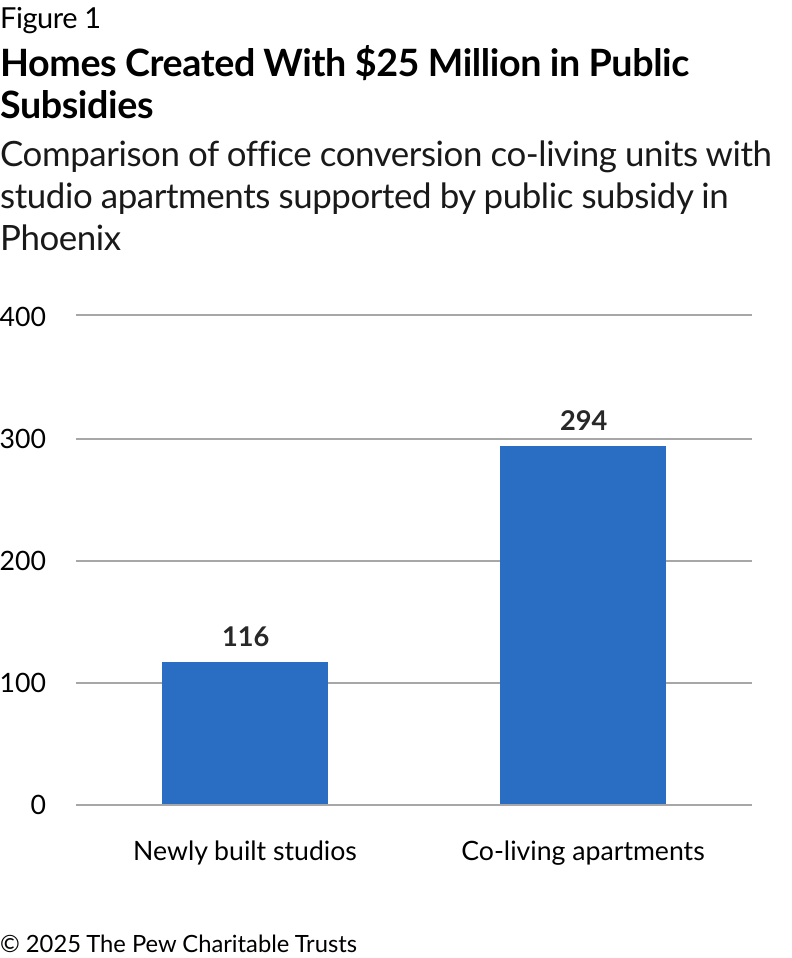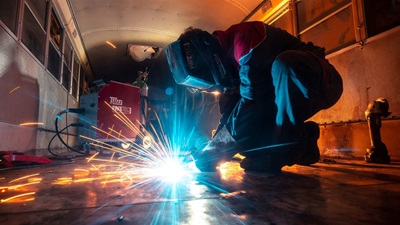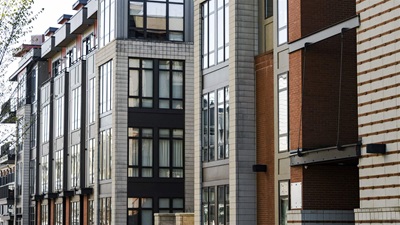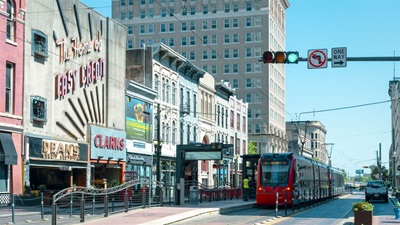Phoenix’s Vacant Office Space Is Well-Suited for Co-Living Conversions
Shared housing model offers cost-effective solution to city’s affordability struggles

With office vacancy rates and housing costs near all-time highs, cities across the United States have been searching for ways to turn empty office space into housing, and particularly into lower-cost homes. But that seemingly promising idea has been hard to realize, in large part because of logistical challenges—primarily, plumbing that is confined to the building’s central core and expanses of interior space without windows.
New research from The Pew Charitable Trusts and Gensler, a global architecture, design, and planning firm, has identified a different solution: Converting offices into dormitory-style “co-living”—small, private micro-apartments with shared kitchens, bathrooms, and living rooms. Office-to-co-living conversions could help address Phoenix’s housing shortage while revitalizing the city’s downtown core, which has an average vacancy rate of 23%.
Development costs and the resulting rents would be well below comparable figures for traditional studio apartments. The Pew/Gensler research found that each co-living unit would cost approximately $169,300 to develop in Phoenix, significantly less than the roughly $300,000 needed to build a studio apartment. With projected rents of $850 per month, these furnished micro-apartments would be affordable to residents earning around 43% of the area’s median income. And all utilities—including electricity for air conditioning—would be included in rent. This type of housing would provide a much-needed option for students, service workers, recent college graduates, and others priced out of Phoenix’s increasingly expensive housing market.
Like much of the Southwest, Arizona has experienced explosive population growth in the 21st century. But the state has not built enough housing to accommodate its 2.4 million new residents, in part because of restrictive zoning and other regulatory barriers. As a result, the cost of owning a home in Arizona increased by 78% in just the past seven years, while rents have also risen.
In metro Phoenix, median rents increased 33% over that same period, to $1,385 per month in August 2025. High rents have helped drive up homelessness statewide; in Maricopa County, which includes Phoenix, the homelessness rate is 20 per 10,000 residents. Research has found that homelessness was rare in the United States when dorm-style housing was plentiful, up until the late 1970s.
Downtown office buildings offer plentiful—and appealing—conversion opportunities
Phoenix has a number of buildings that are ripe for conversion, as the office vacancy rate downtown averaged 23% in the second quarter of 2025. The Pew/Gensler analysis focused on high-rises in the downtown business core that were built between the 1960s and 1990s, which make up more than half the downtown office inventory.
The Pew/Gensler report examines a 38-story building with 20,000 square feet of space on each floor. Private, 160-square-foot individual units line the perimeter, each with a window, bed, desk, storage, microwave, and half-sized refrigerator. A solid core door and soundproofing assure privacy. Kitchens, bathrooms, laundry facilities, and living rooms are located toward the building’s core, where plumbing already exists. Each floor includes four shared kitchens, several living areas, and individual bathrooms. All residents have access to a large fitness center on a lower floor.
The design is extremely efficient, accommodating 50 residents per floor—roughly three times as many as a conventional office-to-studio conversion. Twelve floors would initially be converted to residential use, with a total of 600 micro-apartments. The remaining floors would be available for office space and other uses, and the residential portion could easily be expanded to additional floors if demand warranted.
The Pew/Gensler design also aspires to make co-living attractive as well as inexpensive. An entire floor would be devoted to amenities such as a fitness center and social space. The layout creates natural communities by dividing each large floor into two sections, each serving 25 residents, with access controlled by keycards. Rent would include daily cleaning of shared common areas, and 24-hour security would enhance safety.
Leveraging Phoenix’s existing regulatory advantages
Phoenix offers several advantages as a location for co-living conversions. The city has relatively few regulatory barriers to co-living, and recent reforms have made conversions more feasible. In June 2025, for example, the City Council updated the city’s building codes to facilitate multifamily conversion of commercial buildings, removing density limits for downtown properties.
Arizona’s state Legislature has also enacted policies that support conversions. In April 2025, Governor Katie Hobbs signed bipartisan legislation creating clear standards for adaptive reuse projects in cities with populations over 150,000. The new law requires at least 10% of new units to be designated for low- or moderate-income residents, a standard this co-living concept would readily meet.
The city’s zoning rules allow residential uses in the downtown business core, and Phoenix has flexible parking requirements that allow developers to eliminate parking for projects near transit. The building design envisioned in the Pew/Gensler report assumes there would be no on-site parking for cars but includes 500 bike parking spaces. (There is parking for cars available nearby.)
Financial feasibility requires strategic support
Although the co-living model significantly reduces development costs compared with traditional office-to-apartment conversions, some public funding would probably be needed to make projects financially viable. But subsidy dollars would produce far more housing with this co-living model than with conventional subsidized housing. The projected net operating income (cash flow) for this model conversion suggests that an upfront subsidy of about $85,000 per unit would be needed to make it profitable enough for developers to build. But no ongoing subsidy would be needed. By contrast, a similarly affordable new studio apartment in Phoenix would require a subsidy of about $215,000. A $25 million subsidy would thus produce 294 co-living units, compared with only 116 studio apartments, roughly 2½ times as many homes for the same amount of public support.
Phoenix has several existing programs that could support co-living development, including the city’s Adaptive Reuse Program and the comprehensive Housing Solutions Plan adopted in August 2025. The plan builds on Phoenix’s successful Housing Phoenix Plan, which achieved its goal of creating or preserving 50,000 homes by December 2024—six years ahead of its 2030 target.
Meeting market demand—and revitalizing a city’s downtown
The Pew/Gensler research identified a substantial potential market for this type of housing in Phoenix. Among the area’s 268,000 renter households, 36% include just one person. Approximately 20,000 of those solo renters earn $20,000 to $40,000 annually—the primary intended income range for residents.
An additional 28% of households in that income range have two people; this co-living design could easily be adapted to include double units.
Beyond serving cost-burdened renters, high-rise co-living spaces could support a variety of institutional needs. Universities could lease entire floors for supplemental dorm space. Hospitals could house traveling medical staff. A school district could lease a floor for early-career and hourly employees; an airline or airport could do likewise. The city could use space to provide supportive housing for residents transitioning out of homelessness.
Co-living conversions would benefit Phoenix in other ways. The building envisioned in the Pew/Gensler report would bring 600 new residents to downtown Phoenix, where they would have access to jobs and commerce with short, easy commutes. Nearby businesses would benefit from potential employees and customers.
As Arizona continues to grow—attracting newcomers who can often pay more than longtime residents for scarce homes—co-living conversions offer a way to quickly add low-cost housing inventory in job- and transit-rich locations. Combined with ongoing state and local regulatory reforms, this innovative approach could help Phoenix address its housing shortage while breathing new life into underused downtown office buildings.
With appropriate public support, Phoenix could become a national model for cost-effective office-to-residential conversions by creating modern, affordable homes in the heart of the city.
Alex Horowitz is a project director and Tushar Kansal is a senior officer with The Pew Charitable Trusts’ housing policy initiative.


